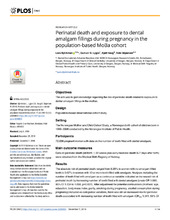Perinatal death and exposure to dental amalgam fillings during pregnancy in the population-based MoBa cohort
Peer reviewed, Journal article
Published version

Åpne
Permanent lenke
https://hdl.handle.net/1956/19695Utgivelsesdato
2018-12-07Metadata
Vis full innførselSamlinger
Originalversjon
https://doi.org/10.1371/journal.pone.0208803Sammendrag
Objectives: The aim was to gain knowledge regarding the risk of perinatal death related to exposure to dental amalgam fillings in the mother. Design: Population-based observational cohort study. Setting: The Norwegian Mother and Child Cohort Study, a Norwegian birth cohort of children born in 1999–2008 conducted by the Norwegian Institute of Public Health. Participants: 72,038 pregnant women with data on the number of teeth filled with dental amalgam. Main outcome measures: Data on perinatal death (stillbirth ≥ 22 weeks plus early neonatal death 0–7 days after birth) were obtained from the Medical Birth Registry of Norway. Results: The absolute risk of perinatal death ranged from 0.20% in women with no amalgam-filled teeth to 0.67% in women with 13 or more teeth filled with amalgam. Analyses including the number of teeth filled with amalgam as a continuous variable indicated an increased risk of perinatal death by increasing number of teeth filled with dental amalgam (crude OR 1.065, 95% CI 1.034 to 1.098, p<0.001). After adjustment for potential confounders (mothers' age, education, body mass index, parity, smoking during pregnancy, alcohol consumption during pregnancy) included as categorical variables, there was still an increased risk for perinatal death associated with increasing number of teeth filled with amalgam (ORadj 1.041, 95% CI 1.008 to 1.076, p = 0.015). By an increased exposure from 0 to 16 teeth filled with amalgam, the model predicted an almost doubled odds ratio (ORadj 1.915, 95% CI 1.12 to 3.28). In groups with 1 to 12 teeth filled with amalgam the adjusted odds ratios were slightly, but not significantly, increased. The group with the highest exposure (participants with 13 or more teeth filled with amalgam) had an adjusted OR of 2.34 (95% CI 1.27 to 4.32; p = 0.007). Conclusion: The current findings suggest that the risk of perinatal death could increase in a dose-dependent way based on the mother’s number of teeth filled with dental amalgam. However, we cannot exclude that the relatively modest odds ratios could be a result of residual confounding. Additional studies on the relationship between exposure to dental amalgam fillings during pregnancy and perinatal death are warranted.
